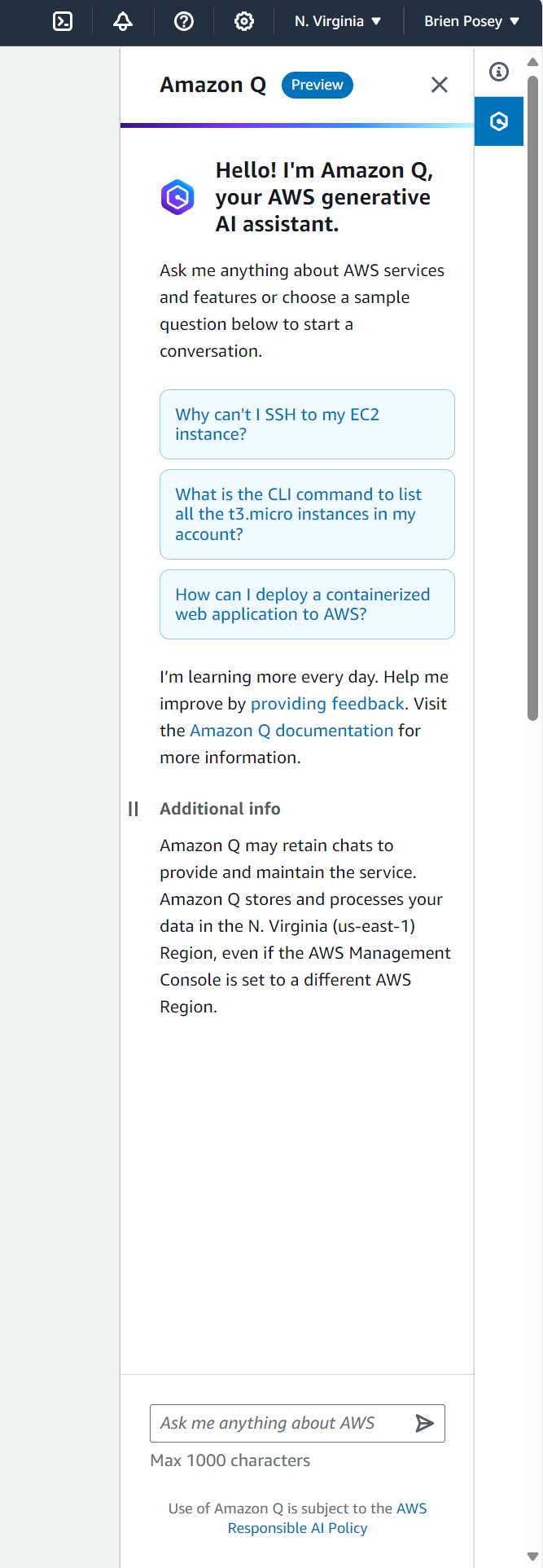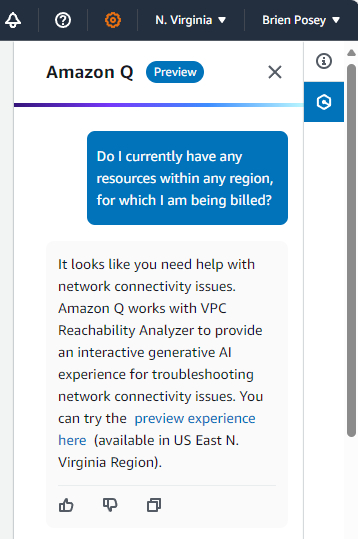In-Depth
Amazon Previews a Generative AI Assistant for AWS
Not to be outdone by ChatGPT, Microsoft Copilot and Google Gemini, Amazon is currently previewing its own AI assistant for AWS, which it calls Amazon Q. Like competing AI assistants, Amazon Q could be described as a cloud-based, large language model (LLM), generative AI assistant.
You can access Amazon Q by simply logging into AWS and then clicking on the Q icon on the far right side of the screen. You can see what the Amazon Q interface looks like in Figure 1.
 [Click on image for larger view.] Figure 1: The Amazon Q Interface Is Exposed Through the AWS Console.
[Click on image for larger view.] Figure 1: The Amazon Q Interface Is Exposed Through the AWS Console.
Being that so many technology companies have created large language model chatbots, it's worth considering Amazon Q's similarities and differences. Before I get into that however, keep in mind that Amazon Q is currently being offered as a preview release, so it seems likely that we may see some changes by the time that Amazon Q is ultimately released. So with that said, Amazon Q has been built around three primary roles.
Amazon Q for Business
The first of these roles is something that Amazon is loosely referring to as Amazon Q for Business use. The idea behind this role is that because organizations store so much business data in the Amazon cloud, it is possible for Amazon Q to leverage that data as a means of providing business insight.
Although AI development is notoriously difficult, Amazon has simplified the process by providing customers with an API and an SDK that they can use to interact with Amazon Q. These tools handle all of the complexities associated with connecting to Amazon Q and also allow the experience to be customized. Organizations can choose the data that should -- and should not -- be ingested by the AI engine. Organizations can optionally configure Amazon Q to use publicly available knowledge, rather than relying exclusively on their own business data.
One of the things that business users will likely find to be especially helpful about the way that Amazon Q works is that when Amazon Q generates a response, it automatically cites the sources that were used in generating that response. This is important because over the last couple of years, we have all seen examples of AI going off the rails and generating a response that defies logic. Needless to say, you really don't want to be making business decisions based on these types of AI anomalies, often referred to as "hallucinations." As such, Amazon Q points to the information that it used to formulate its response. That way, if a response seems questionable, you have a way of looking at the background information to determine whether it is in the organization's best interest to accept the response at face value.
Amazon Q for Builders
The second major way in which Amazon Q is being used is for software development. Like ChatGPT, Amazon Q is able to generate code based on text input describing what is needed. While such capabilities are undeniably useful, there are a few other capabilities that are worth mentioning. For example, Amazon Q is specifically designed to help developers to build on the Amazon platform. In other words, Amazon Q can do more than just write code. It also contains built-in knowledge of how to use that code to create and host applications in the Amazon cloud. Additionally, Amazon Q can help organizations to refactor code, which is often required prior to migrating an application to the cloud. Amazon Q is also able to help optimize code or to update existing code to a new version.
Amazon Q for Admins
Amazon Q's third role is that it can assist IT pros with using the AWS cloud. This is the role that is illustrated in the screen capture shown earlier in the article. As you can see in the figure, Amazon Q can answer basic questions that you may have when interacting with the AWS console. If for example, you are having trouble accessing an EC2 instance, then Amazon Q can walk you through the troubleshooting process. Amazon Q can also guide you through the completion of unfamiliar tasks.
Incidentally, Amazon is in the process of building special-purpose tools (based on Amazon Q) into the AWS console as a way of making common tasks easier. For example, there is an Amazon Q-based tool in the EC2 console that can help you pick the optimal instance type based on the workload that will be running on the instance.
Although Amazon Q has tremendous potential, Amazon still has a few bugs to work out before the end of the preview period. As I was writing this article, I began to wonder if Amazon Q could help with billing issues. As such, I asked Amazon Q if I had any resources deployed for which I was currently being billed. As you can see in Figure 2 however, Amazon Q misinterpreted my question and thought that I was having network connectivity problems with a VPC.
 [Click on image for larger view.] Figure 2: Amazon Q Totally Misunderstood My Question.
[Click on image for larger view.] Figure 2: Amazon Q Totally Misunderstood My Question.
In spite of this hiccup, I think that as time goes on, Amazon Q will prove to be an invaluable resource for anyone who works with the Amazon cloud.
About the Author
Brien Posey is a 22-time Microsoft MVP with decades of IT experience. As a freelance writer, Posey has written thousands of articles and contributed to several dozen books on a wide variety of IT topics. Prior to going freelance, Posey was a CIO for a national chain of hospitals and health care facilities. He has also served as a network administrator for some of the country's largest insurance companies and for the Department of Defense at Fort Knox. In addition to his continued work in IT, Posey has spent the last several years actively training as a commercial scientist-astronaut candidate in preparation to fly on a mission to study polar mesospheric clouds from space. You can follow his spaceflight training on his Web site.